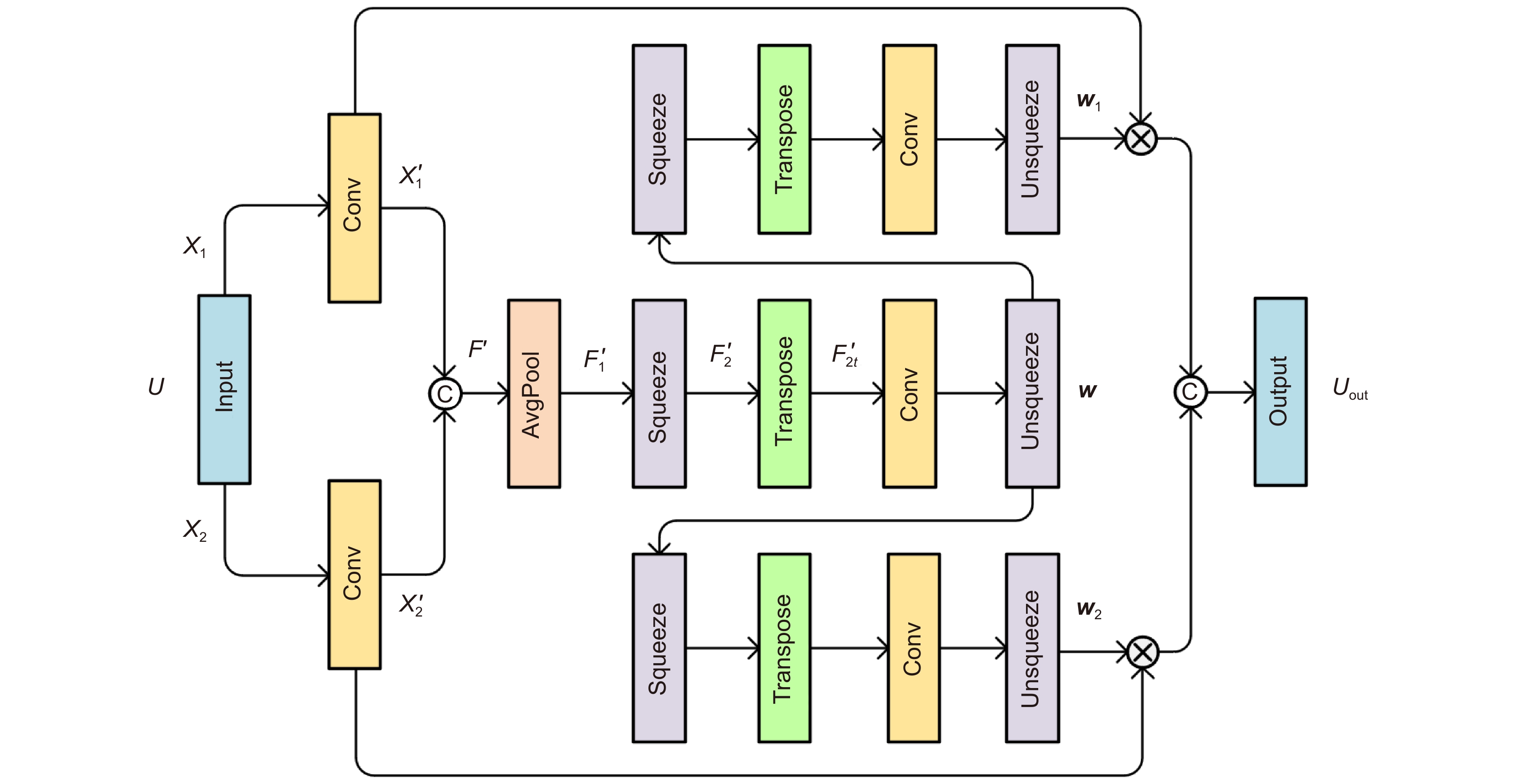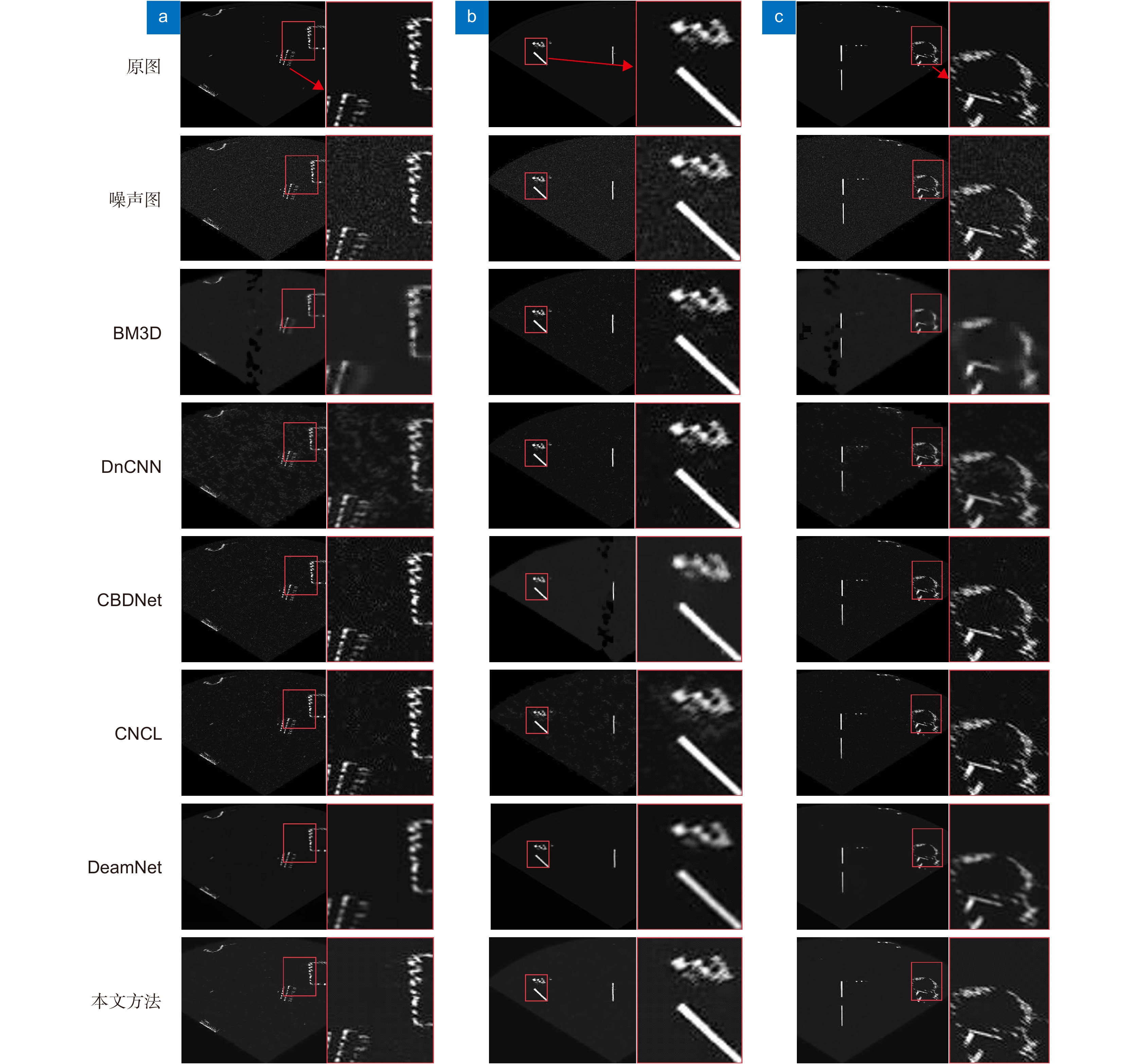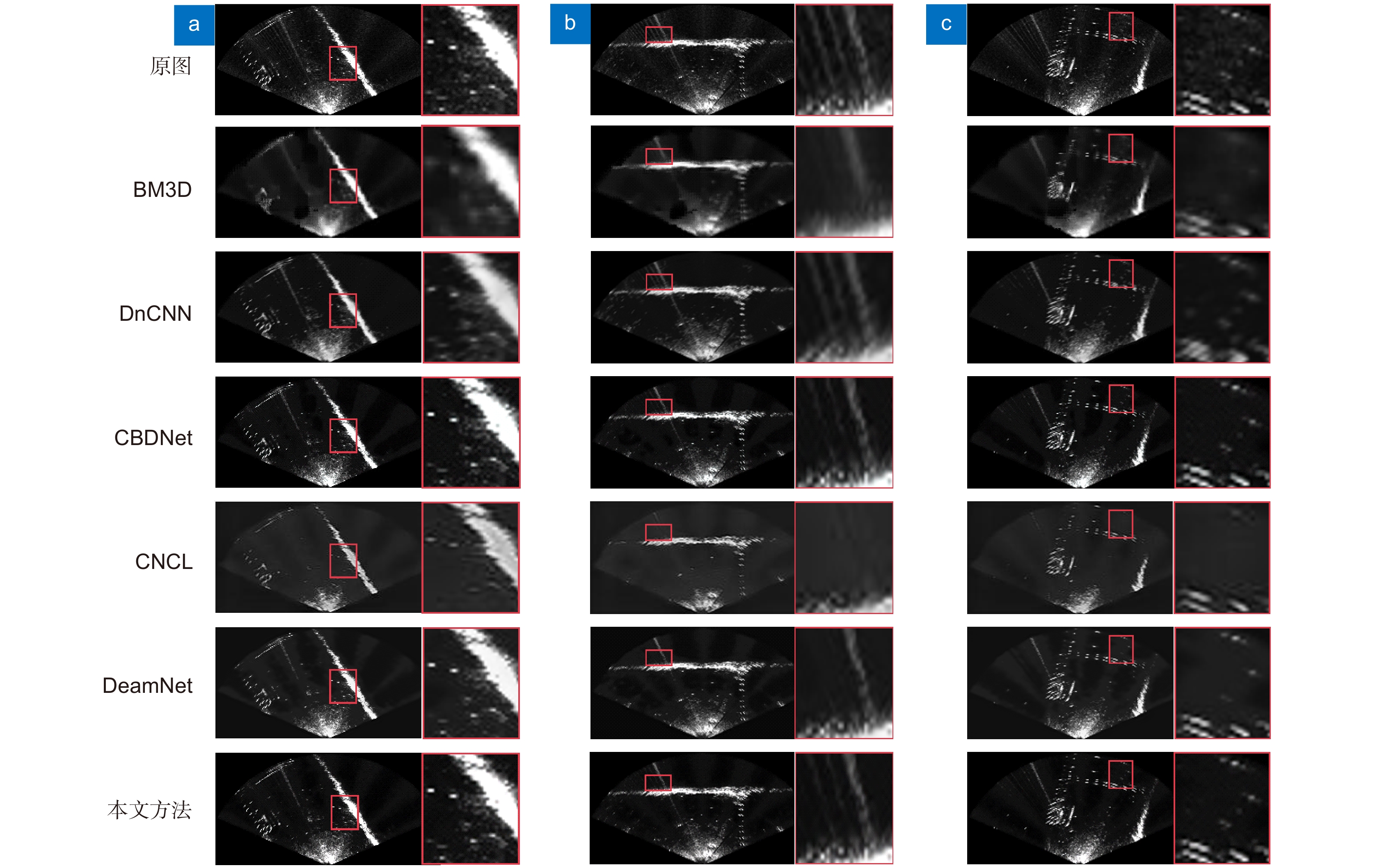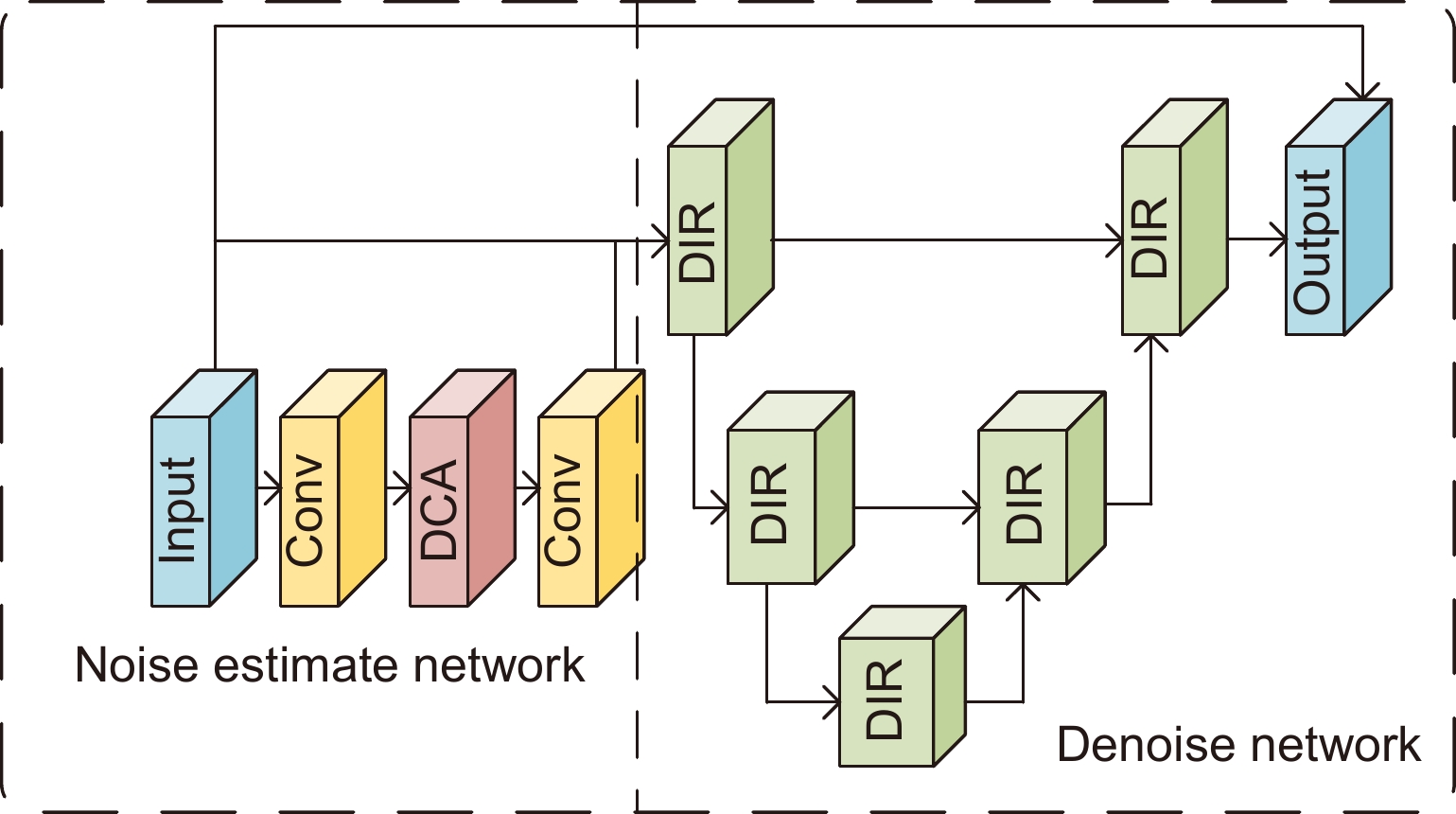-
摘要:
前视声呐作为一种水下主动声呐设备常用于采集水下图像数据,然而会受到水下噪声的影响导致图像质量下降。针对这一问题,本文提出了一种基于密集残差和双通道注意力机制网络的前视声呐图像去噪方法。首先采用双通道注意力机制对声呐图像的通道信息进行提取,统计声呐图像的全局信息,输出声呐图像的噪声图;密集残差块根据噪声图和声呐图像,充分学习不同尺度上的特征信息,经过多次学习和信息传递后输出干净声呐图像。针对前视声呐图像及其噪声特点,模拟了前视声呐图像并添加瑞利分布的乘性噪声和高斯分布的加性噪声,生成模拟数据集用于网络训练和性能评估。在模拟数据集和真实数据集的实验中表明,本文方法能够有效去除噪声,保留图像细节。
Abstract:As a kind of underwater active sonar equipment, forward-looking sonar is often used to collect underwater image data. However, it will be affected by underwater noise, which leads to the degradation of image quality. Due to this situation, a forward-looking sonar image denoising method is proposed based on dense residuals and a dual-channel attention mechanism network. Firstly, the two-channel attention mechanism is adopted to extract the channel information of the sonar image, collect the global information of the sonar image, and output the noise map of the sonar image. Based on the noise image and sonar image, the dense residual block fully learns the feature information at different scales and outputs a clean sonar image after multiple learning and information transfer. Because of the forward-looking sonar image and its noise characteristics, the forward-looking sonar image is simulated and the multiplicative noise of Rayleigh distribution and the additive noise of Gaussian distribution are added to generate a simulation dataset for network training and performance evaluation. Experimental results on the simulated data set and real data set show that the proposed method can effectively remove the noise and retain image details.
-
Key words:
- forward looking sonar /
- image denoising /
- noise simulate /
- channel attention /
- dense residual
-
Overview: As a kind of underwater active sonar equipment, forward-looking sonar is often used to collect underwater image data. However, it will be affected by underwater noise, which leads degradation of image quality. Due to this situation, a forward-looking sonar image denoising method is proposed based on dense residuals and a dual-channel attention mechanism network. Firstly, the dual attention mechanism is adopted to extract the channel information of the sonar image, collect the global information of the sonar image, and output the noise map of the sonar image. Based on the noise image and sonar image, the dense residual block fully learns the feature information at different scales, and outputs a clean sonar image after multiple learning and information transfer. The main contributions of this paper are as follows.
a) The dual channel attention module is used to estimate the noise, which adaptively accepts information of different scales through two paths using 3×3 and 5×5 convolutional kernels, respectively, and shunts these information to the next layer of neurons to enhance the feature extraction capability of the module, and then uses one-dimensional convolution to generate a channel attention map to extract the interdependencies between features maps, acquiring more information while reducing the computational volume.
b) Dense in residual module is used to remove noise. This module replaces the 3×3 convolutional layers in the traditional residual block with component group convolutions to reduce the number of parameters and improve the training speed, followed by dense and residual connections designed inside the convolutional kernel to learn the differences and connections between feature maps of different sizes, to transfer the learned information from each layer more smoothly and avoid performance degradation and the problem of gradient explosion and disappearance, and finally improve the multi-scale information extraction capability of the network at a fine granularity level.
In this paper, we simulate the generation of forward-looking sonar images by FieldII and add simulated multiplicative Rayleigh noise and additive Gaussian noise to generate a training set for training the network. Later, comparison experiments are conducted on the simulated data test set and the real data set, and the good performance of the proposed method is demonstrated in terms of PSNR, SSIM, and Brisquet image comparison metrics.
-

-
表 1 模拟声呐图像去噪结果
Table 1. simulated sonar image denoising results
表 2 真实声呐图像去噪评价指标结果表
Table 2. Real sonar image denoising evaluation index results
表 3 不同注意力机制的比较
Table 3. Comparison of different attention mechanisms
模型 模拟数据集 真实数据集 PSNR SSIM Brisque Brisque 单路注意力 35.68 0.8276 94.19 41.61 DCA 36.54 0.8450 91.13 40.28 表 4 不同残差块的比较
Table 4. Comparison of different residual block
模型 模拟数据集 真实数据集 PSNR SSIM Brisque Brisque 普通残差块 35.98 0.8367 95.26 41.34 DIR 36.54 0.8450 91.13 40.28 表 5 消融实验结果对比
Table 5. Comparison of ablation results
方法 模拟数据集 真实数据集 PSNR SSIM Brisque Brisque CBDNet 34.66 0.7852 98.82 42.58 CBDNet+DCA 35.87 0.7961 97.48 41.89 CBDNet+DIR 35.43 0.8257 98.31 42.04 CNCL 34.54 0.7817 94.68 45.27 CNCL+DCA 34.84 0.7746 94.42 44.35 CNCL+DIR 35.02 0.7993 92.88 43.79 本文 36.54 0.8450 91.13 40.28 -
[1] 曾腾, 任露露, 王宇杰, 等. 基于组合特征的水下三维目标检测跟踪算法[J]. 兵工学报. https://doi.org/10.12382/bgxb.2022.0017.
Zeng T, Ren L L, Wang Y J, et al. Feature-based underwater three-dimensional sonar target detection and tracking algorithm[J]. Acta Armam. https://doi.org/10.12382/bgxb.2022.0017.
[2] Chuang K S, Tzeng H L, Chen S R, et al. Fuzzy c-means clustering with spatial information for image segmentation[J]. Comput Med Imag Grap, 2006, 30(1): 9−15. doi: 10.1016/j.compmedimag.2005.10.001
[3] Yang H Y, Wang X Y, Niu P P, et al. Image denoising using nonsubsampled shearlet transform and twin support vector machines[J]. Neural Netw, 2014, 57: 152−165. doi: 10.1016/j.neunet.2014.06.007
[4] Shao L, Yan R M, Li X L, et al. From heuristic optimization to dictionary learning: a review and comprehensive comparison of image denoising algorithms[J]. IEEE Trans Cybern, 2014, 44(7): 1001−1013. doi: 10.1109/TCYB.2013.2278548
[5] Buades A, Coll B, Morel J M. A review of image denoising algorithms, with a new one[J]. Multiscale Model Simul, 2005, 4(2): 490−530. doi: 10.1137/040616024
[6] Wu D, Du X, Wang K Y. An effective approach for underwater sonar image denoising based on sparse representation[C]//Proceedings of the 2018 IEEE 3rd International Conference on Image, Vision and Computing. Chongqing: IEEE, 2018: 389–393. https://doi.org/10.1109/ICIVC.2018.8492877.
[7] Jiang S Y, Xing C X, Wan Z L, et al. Research on multiplicative speckle noise denoising method of side-scan sonar image based on analysis sparse decomposition[C]//Proceedings of 2021 OES China Ocean Acoustics. Harbin: IEEE, 2021: 1016–1020. https://doi.org/10.1109/COA50123.2021.9519941.
[8] Chen M, Li L, Li Z J, et al. Research on sonar image denoising method based on fixed water area noise model[C]//Proceedings of 2021 IEEE International Conference on Mechatronics and Automation. Takamatsu: IEEE, 2021: 231–235. https://doi.org/10.1109/ICMA52036.2021.9512575.
[9] Stolojescu-Crisan C, Isar A. A new automatic conditioning algorithm for SONAR images[C]//Proceedings of 2021 International Symposium on Signals, Circuits and Systems. Iasi: IEEE, 2021: 1–4. https://doi.org/10.1109/ISSCS52333.2021.9497424.
[10] 范习健, 李庆武, 黄河, 等. 侧扫声呐图像的3维块匹配降斑方法[J]. 中国图象图形学报, 2012, 17(1): 68−74. doi: 10.11834/jig.20120110
Fan X J, Li Q W, Huang H, et al. Side-scan sonar image despeckling based on block-matching and 3D filtering[J]. J Image Grap, 2012, 17(1): 68−74. doi: 10.11834/jig.20120110
[11] 陈朋, 蔡烜伟, 赵冬冬, 等. 基于自适应BM3D的侧扫声纳图像散斑降噪[J]. 光电工程, 2020, 47(7): 190580. doi: 10.12086/oee.2020.190580
Chen P, Cai X W, Zhao D D, et al. Despeckling for side-scan sonar images based on adaptive block-matching and 3D filtering[J]. Opto-Electron Eng, 2020, 47(7): 190580. doi: 10.12086/oee.2020.190580
[12] Zhang K, Zuo W M, Zhang L. FFDNet: toward a fast and flexible solution for CNN-based image denoising[J]. IEEE Trans Image Process, 2018, 27(9): 4608−4622. doi: 10.1109/TIP.2018.2839891
[13] Zhang K, Zuo W M, Chen Y J, et al. Beyond a gaussian denoiser: residual learning of deep CNN for image denoising[J]. IEEE Trans Image Process, 2017, 26(7): 3142−3155. doi: 10.1109/TIP.2017.2662206
[14] 公绪超, 李宗民. 深度非对称跳跃连接的图像降噪方法[J]. 计算机辅助设计与图形学学报, 2019, 31(2): 295−302. doi: 10.3724/SP.J.1089.2019.17285
Gong X C, Li Z M. An image denoising method using deep asymmetrical skip connection[J]. J Comput Aided Des Comput Grap, 2019, 31(2): 295−302. doi: 10.3724/SP.J.1089.2019.17285
[15] He K M, Zhang X Y, Ren S Q, et al. Deep residual learning for image recognition[C]//Proceedings of 2016 IEEE Conference on Computer Vision and Pattern Recognition. Las Vegas: IEEE, 2016: 770–778. https://doi.org/10.1109/CVPR.2016.90.
[16] Gao S H, Cheng M M, Zhao K, et al. Res2Net: a new multi-scale backbone architecture[J]. IEEE Trans Pattern Anal Mach Intell, 2021, 43(2): 652−662. doi: 10.1109/TPAMI.2019.2938758
[17] Huang G, Liu Z, Van Der Maaten L, et al. Densely connected convolutional networks[C]//Proceedings of 2017 IEEE Conference on Computer Vision and Pattern Recognition. Honolulu: IEEE, 2017: 2261–2269. https://doi.org/10.1109/CVPR.2017.243.
[18] Ledig C, Theis L, Huszár F, et al. Photo-realistic single image super-resolution using a generative adversarial network[C]//Proceedings of 2017 IEEE Conference on Computer Vision and Pattern Recognition. Honolulu: IEEE, 2017: 105–114. https://doi.org/10.1109/CVPR.2017.19.
[19] 王晓娜, 黄宇然, 匡翠方, 等. 基于反卷积的手机屏下成像图像恢复[J]. 光电工程, 2021, 48(6): 200423. doi: 10.12086/oee.2021.200423
Wang X N, Huang Y R, Kuang C F, et al. Image restoration of mobile phone under-screen imaging based on deconvolution[J]. Opto-Electron Eng, 2021, 48(6): 200423. doi: 10.12086/oee.2021.200423
[20] Cheng S, Wang Y Z, Huang H B, et al. NBNet: noise basis learning for image denoising with subspace projection[C]//Proceedings of 2021 IEEE/CVF Conference on Computer Vision and Pattern Recognition. Nashville: IEEE, 2021: 4894–4904. https://doi.org/10.1109/CVPR46437.2021.00486.
[21] Ronneberger O, Fischer P, Brox T. U-Net: convolutional networks for biomedical image segmentation[C]//Proceedings of the 18th International Conference on Medical Image Computing and Computer-Assisted Intervention. Munich: Springer, 2015. https://doi.org/10.1007/978-3-319-24574-4_28.
[22] Hu J, Shen L, Albanie S, et al. Squeeze-and-excitation networks[J]. IEEE Trans Pattern Anal Mach Intell, 2020, 42(8): 2011−2023. doi: 10.1109/TPAMI.2019.2913372
[23] Wang Q L, Wu B G, Zhu P F, et al. ECA-Net: efficient channel attention for deep convolutional neural networks[C]// Proceedings of 2020 IEEE/CVF Conference on Computer Vision and Pattern Recognition. Seattle: IEEE, 2020: 11531–11539. https://doi.org/10.1109/CVPR42600.2020.01155.
[24] Li X, Wang W H, Hu X L, et al. Selective kernelnetworks[C]//Proceedings of 2019 IEEE/CVF Conference onComputer Vision and Pattern Recognition. Long Beach: IEEE,2019: 510–519. https://doi.org/10.1109/CVPR.2019.00060.
[25] 王海林, 于倩, 李彤, 等. 基于CS-ANN的软件缺陷预测模型研究[J]. 计算机应用研究, 2017, 43(2): 467−472,476. doi: 10.3969/j.issn.1001-3695.2017.02.033
Wang H L, Yu Q, Li T, et al. Research of software defect prediction model based on CS-ANN[J]. Appl Res Comput, 2017, 43(2): 467−472,476. doi: 10.3969/j.issn.1001-3695.2017.02.033
[26] Tian C W, Xu Y, Li Z Y, et al. Attention-guided CNN for image denoising[J]. Neural Netw, 2020, 124: 117−129. doi: 10.1016/j.neunet.2019.12.024
[27] Guo S, Yan Z F, Zhang K, et al. Toward convolutional blind denoising of real photographs[C]//Proceedings of 2019 IEEE/CVF Conference on Computer Vision and Pattern Recognition. Long Beach: IEEE, 2019: 1712–1722. https://doi.org/10.1109/CVPR.2019.00181.
[28] Jensen J A, Svendsen N B. Calculation of pressure fields from arbitrarily shaped, apodized, and excited ultrasound transducers[J]. IEEE Trans Ultrason Ferroelectr Freq Control, 1992, 39(2): 262−267. doi: 10.1109/58.139123
[29] Yu Y J, Acton S T. Speckle reducing anisotropic diffusion[J]. IEEE Trans Image Process, 2002, 11(11): 1260−1270. doi: 10.1109/TIP.2002.804276
[30] Karabchevsky S, Kahana D, Ben-Harush O, et al. FPGA-based adaptive speckle suppression filter for underwater imaging sonar[J]. IEEE J Oceanic Eng, 2011, 36(4): 646−657. doi: 10.1109/JOE.2011.2157729
[31] Bamber J C, Dickinson R J. Ultrasonic B-scanning: a computer simulation[J]. Phys Med Biol, 1980, 25(3): 463−479. doi: 10.1088/0031-9155/25/3/006
[32] Short J R. High-frequency ambient noise and its impact on underwater tracking ranges[J]. IEEE J Oceanic Eng, 2005, 30(2): 267−274. doi: 10.1109/JOE.2004.836991
[33] Abd-Elmoniem K Z, Youssef A B M, Kadah Y M. Real-time speckle reduction and coherence enhancement in ultrasound imaging via nonlinear anisotropic diffusion[J]. IEEE Trans Biomed Eng, 2022, 49(9): 997−1014. doi: 10.1109/TBME.2002.1028423
[34] Giacomo G, Machado M, Drews P, et al. Sonar-to-satellite translation using deep learning[C]//Proceedings of the 2018 17th IEEE International Conference on Machine Learning and Applications. Orlando: IEEE, 2018: 454–459. https://doi.org/10.1109/ICMLA.2018.00074.
[35] Mittal A, Moorthy A K, Bovik A C. No-reference image quality assessment in the spatial domain[J]. IEEE Trans Image Process, 2012, 21(12): 4695−4708. doi: 10.1109/TIP.2012.2214050
[36] Geng M F, Meng X X, Yu J Y, et al. Content-noise complementary learning for medical image denoising[J]. IEEE Trans Med Imaging, 2022, 41(2): 407−419. doi: 10.1109/TMI.2021.3113365
[37] Ren C, He X H, Wang C C, et al. Adaptive consistency prior based deep network for image denoising[C]//Proceedings of 2021 IEEE/CVF Conference on Computer Vision and Pattern Recognition. Nashville: IEEE, 2021: 8592–8602. https://doi.org/10.1109/CVPR46437.2021.00849.
-


 E-mail Alert
E-mail Alert RSS
RSS
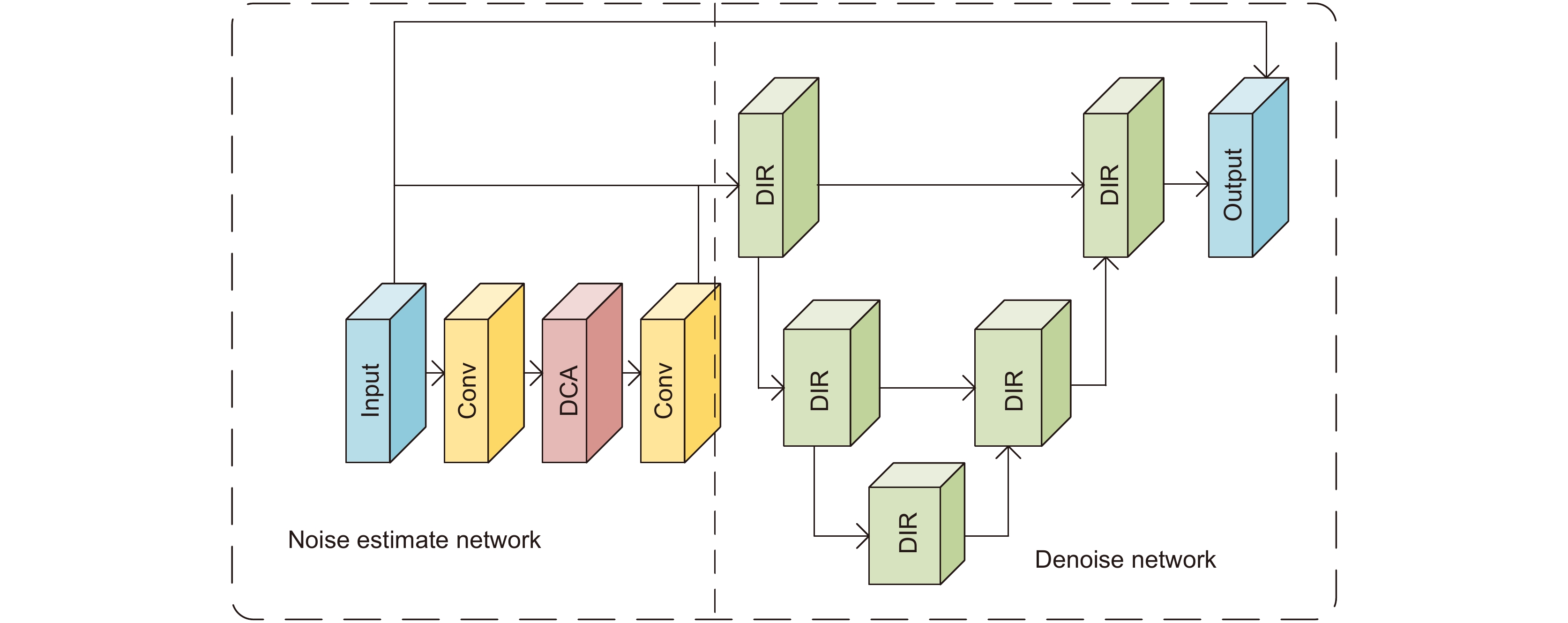
 下载:
下载:
